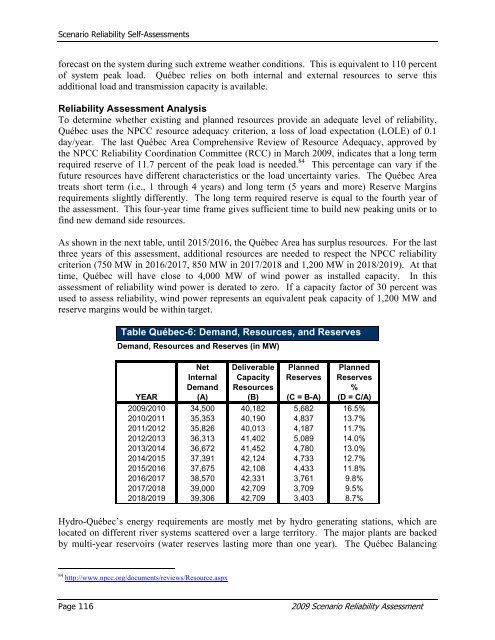2009 Scenario Reliability Assessment - NERC
2009 Scenario Reliability Assessment - NERC
2009 Scenario Reliability Assessment - NERC
- No tags were found...
You also want an ePaper? Increase the reach of your titles
YUMPU automatically turns print PDFs into web optimized ePapers that Google loves.
<strong>Scenario</strong> <strong>Reliability</strong> Self-<strong>Assessment</strong>sforecast on the system during such extreme weather conditions. This is equivalent to 110 percentof system peak load. Québec relies on both internal and external resources to serve thisadditional load and transmission capacity is available.<strong>Reliability</strong> <strong>Assessment</strong> AnalysisTo determine whether existing and planned resources provide an adequate level of reliability,Québec uses the NPCC resource adequacy criterion, a loss of load expectation (LOLE) of 0.1day/year. The last Québec Area Comprehensive Review of Resource Adequacy, approved bythe NPCC <strong>Reliability</strong> Coordination Committee (RCC) in March <strong>2009</strong>, indicates that a long termrequired reserve of 11.7 percent of the peak load is needed. 84 This percentage can vary if thefuture resources have different characteristics or the load uncertainty varies. The Québec Areatreats short term (i.e., 1 through 4 years) and long term (5 years and more) Reserve Marginsrequirements slightly differently. The long term required reserve is equal to the fourth year ofthe assessment. This four-year time frame gives sufficient time to build new peaking units or tofind new demand side resources.As shown in the next table, until 2015/2016, the Québec Area has surplus resources. For the lastthree years of this assessment, additional resources are needed to respect the NPCC reliabilitycriterion (750 MW in 2016/2017, 850 MW in 2017/2018 and 1,200 MW in 2018/2019). At thattime, Québec will have close to 4,000 MW of wind power as installed capacity. In thisassessment of reliability wind power is derated to zero. If a capacity factor of 30 percent wasused to assess reliability, wind power represents an equivalent peak capacity of 1,200 MW andreserve margins would be within target.Table Québec-6: Demand, Resources, and ReservesDemand, Resources and Reserves (in MW)Net Deliverable Planned PlannedInternal Capacity Reserves ReservesDemand Resources %YEAR (A) (B) (C = B-A) (D = C/A)<strong>2009</strong>/2010 34,500 40,182 5,682 16.5%2010/2011 35,353 40,190 4,837 13.7%2011/2012 35,826 40,013 4,187 11.7%2012/2013 36,313 41,402 5,089 14.0%2013/2014 36,672 41,452 4,780 13.0%2014/2015 37,391 42,124 4,733 12.7%2015/2016 37,675 42,108 4,433 11.8%2016/2017 38,570 42,331 3,761 9.8%2017/2018 39,000 42,709 3,709 9.5%2018/2019 39,306 42,709 3,403 8.7%Hydro-Québec’s energy requirements are mostly met by hydro generating stations, which arelocated on different river systems scattered over a large territory. The major plants are backedby multi-year reservoirs (water reserves lasting more than one year). The Québec Balancing84 http://www.npcc.org/documents/reviews/Resource.aspxPage 116<strong>2009</strong> <strong>Scenario</strong> <strong>Reliability</strong> <strong>Assessment</strong>
















